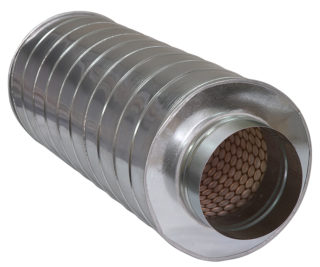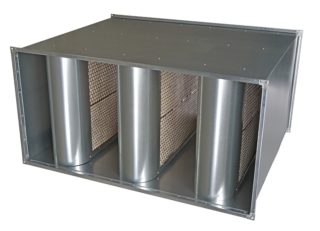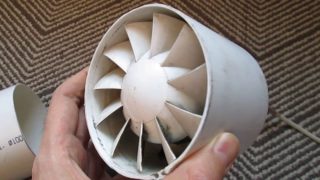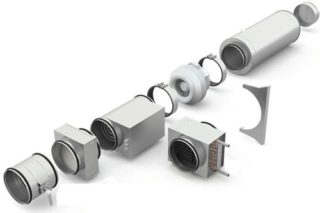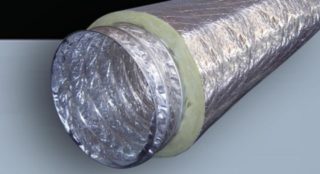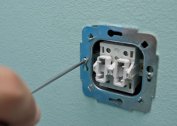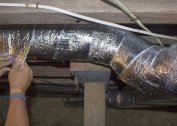A sound absorber for ventilation is an invaluable tool to reduce loud sounds that occur in the supply and exhaust systems installed in residential and utility rooms. This device allows you to create a healthy and comfortable environment in a confined space even at night, when people need silence for a good rest. On sale are many silencers for ventilation, differing in device, size and pricing. To choose a silencer for ventilation, you should familiarize yourself with the features, differences and principles of operation of these devices.
Principle of operation of a silencer for ventilation
In the process of air movement through communications, unwanted noises inevitably arise that distract from work, get on your nerves, and interfere with sleep. Even a short stay in such conditions is unpleasant.
Noises in the channels occur under the influence of such factors:
- rotation of the propeller or drum blades;
- turbulence arising in the channels of square and rectangular section;
- the presence of foreign objects, dirt, fragments of the frozen mortar.
Ventilation silencers are used in forced-type systems. By themselves, these products do not increase their effectiveness and in no way affect the cleaning of the air entering the premises. Their purpose is to reduce the volume of sound that occurs when the electric propeller rotates.
The principle of operation of the ventilation silencer is to absorb noise with soundproof materials that are located around the ducts. This is a simple, inexpensive, but effective design, equally well suited for residential and industrial facilities.
Existing types of silencers
On sale are many models of silencers that work on the same principle, but differ in technical characteristics.
According to the internal structure of the product are divided into the following categories:
- Tubular. They are a double structure, where one pipe is located inside another, having a larger diameter. The inner part has openings, and the outer whole and smooth walls. The gap between the sections is filled with soundproofing material so that there are no voids left. In shape of the cross section, the tubular silencer for ventilation can be round, square and rectangular. The cross section of the inner pipe must match or be larger than the channel in which the device is installed. In most cases, such silencers are mounted on highways with a diameter of up to 50 cm. The length of the device itself is limited to 120 cm.
- Lamellar. They are made in the form of boxes with lamellar jumpers installed inside. By design, products resemble mufflers for cars. The plates are covered with soundproof material, which absorbs loud sounds. The distance between the plates varies between 7-30 cm and can be adjusted. Reducing the interval reduces noise, but system throughput also degrades. A plate silencer for ventilation can only be installed in a system with rectangular channels.
As insulating material, basalt or glass wool, felt, wool and similar materials are used.
Device Dimensions and Sound Absorption
When choosing a ventilation silencer, you need to focus on the conformity of its dimensions to the parameters of the duct, the size and layout of the premises. The dyne of a product of 60-80 cm is considered to be the best option. This length is usually enough to effectively neutralize the sounds that the blades of a household fan make. If the hood is powerful and loud, you will need to take a device with a length of 120 cm. Larger devices should not be taken or made, since they become sources of indirect noise. It is better to put two medium devices or disassemble one large one and install half at a distance of 70-100 cm from each other.
The second factor that you need to pay attention to is the indicator of lowering the volume of sounds produced by the technique. The optimal level is 10-15 dB. This information is indicated in the product instructions. If the indicators are lower for practical measurements, this is an occasion to return the purchase to the store. Most likely this is a fake, in the production process of which the technology was violated or low-quality heat insulators were used.
It is recommended that the silencers be fitted close to the fan. This technique allows you to catch all the noise until they enter the duct.
Features of use
There are no requirements and regulations regarding mandatory installation, installation location, types and sizes of devices. The only rule is to maintain the system capacity at a level that provides the necessary air exchange rate for a room of this type.
Installation of a noise absorber is carried out at the initiative of the property owner.
If this procedure is performed in a multi-storey building, the following rules must be observed:
- all work is only within the boundaries of his apartment, without interference with the public construction;
- it is forbidden to remove exhaust ducts from gas equipment to vertical shafts not intended for this purpose;
- when ventilating to the street, it is necessary to coordinate with the managing organization the location of drilling the wall to prevent the weakening of its bearing capacity.
If the actual air velocity exceeds the calculated one, the product productivity decreases, and in some cases the opposite effect can be observed when the silencers begin to make noise more loudly than the fans themselves.
Selection rules
There are no statutory regulations regarding the choice of silencers for ventilation.
The following criteria should be taken into account:
- noise reduction parameters prescribed by the manufacturer;
- maximum throughput;
- operating temperature range;
- the presence or ability to install filters;
- section and shape of the pipe;
- compliance of the inner diameter with the parameters of the duct;
- product orientation during installation;
- length and outer diameter.
If the product will be in sight, you need to pay attention to its appearance and evaluate the possibility of subsequent decoration for the interior of the room.
Installation guide
The installation process of the silencer is not particularly difficult, any home master can easily cope with it.
Installation should be carried out in the following sequence:
- Take measurements, mark up.
- Make a cut in the duct corresponding to the length of the muffler, taking into account the connecting parts.
- Insert the product into the cut, secure with the included clips or your screws and clamps.
- Seal joints with sealant.
- Decorate the assembled structure.
If space permits, additional sound insulation can be installed on top of the muffler. This will guarantee to get rid of noise.
DIY silencer manufacturing
If you have the initial repair skills, you can save a lot by making a muffler with your own hands.
To work, you will need:
- roulette;
- drill, grinder;
- screwdriver;
- file;
- hammer;
- thermal insulation material;
- self-tapping screws;
- plastic clamps;
- a pipe corresponding to the parameters of the duct;
- the second pipe with a large diameter / cross section of 7-10 cm;
- sealant.
The work is carried out in the following sequence:
- Sawing the same lengths of pipe.
- Perforation of the inner fragment with holes with a diameter of 3-5 mm with an interval of 1 cm.
- Wrapping the inner part with a sheet sound insulator. Fixing the material with plastic ties.
- Notching the edges of the outer pipe and bending the petals out.
- Insertion of the inner fragment into the outer. Fixing them using petals.
- Decorating the finished product. You can use color film, paint, wallpaper.
It remains to install a silencer and enjoy the silence.
